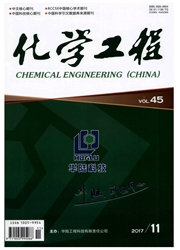

 中文摘要:
中文摘要:
为掌握CO变换制氢过程中催化剂中毒机理,采用热力学非均相反应体系中G ibbs自由能最小原理,分析了铜基低温变换催化剂在463.15—523.15 K内H2S中毒过程中可能发生的化学反应及其产物,并结合文献实验结果综合讨论了铜基低温变换催化剂的H2S中毒机理。结果表明:催化剂的H2S中毒过程中,硫酸盐和积碳会造成催化剂的暂时性中毒,生成Cu2S和CuS化合物造成永久性中毒;O2的存在会加快催化剂的中毒反应;铜基低温变换催化剂不适合用于含高体积分数CO原料气的变换反应过程。
 英文摘要:
英文摘要:
The catalyst poisoning mechanism in the process of CO conversion to hydrogen was studied by employing the Gibbs free energy minimization principle of the thermodynamics non-homogeneous reaction system.The possible chemical reactions and products in the sulfureted hydrogen(H2S) poisoning process of copper-based catalyst for low temperature water-gas shift were analyzed at 463.15-523.15 K.Furthermore,the H2S poisoning mechanism was discussed comprehensively in combination with literature experimental results.The results show that in the process of catalyst H2S poisoning,sulfides and accumulated carbon can cause catalyst poisoning temporarily and generate cuprous sulfide(Cu2S) and copper sulphide(CuS) compounds,which result in permanent poisoning.The presence of oxygen accelerates catalyst poisoning reaction.Copper-based low temperature shift catalyst is not suitable for the gas shift reaction process in which feed gas contains high volume fraction of CO.
 同期刊论文项目
同期刊论文项目
 同项目期刊论文
同项目期刊论文
 期刊信息
期刊信息
